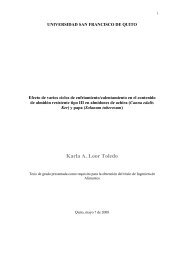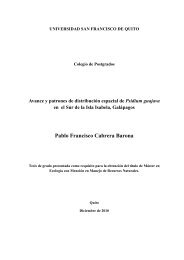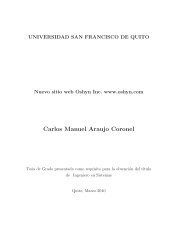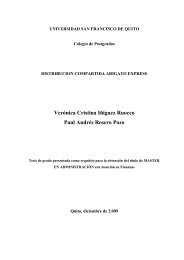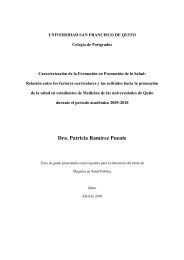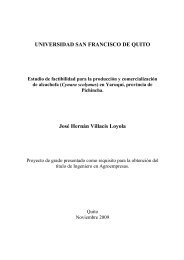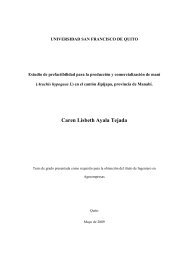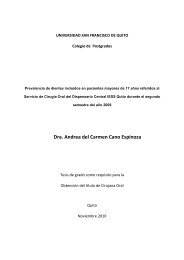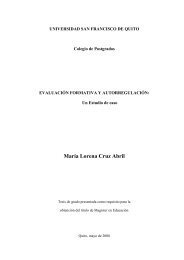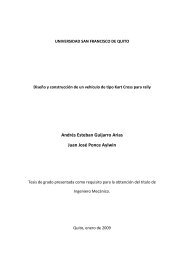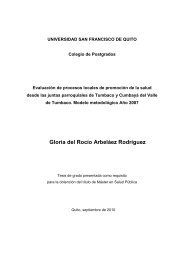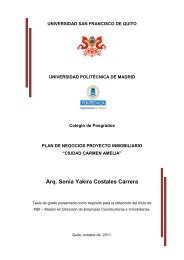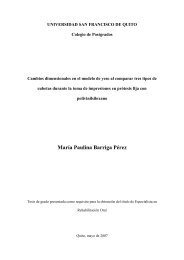Myriam Elizabeth Saavedra López - Repositorio Digital USFQ ...
Myriam Elizabeth Saavedra López - Repositorio Digital USFQ ...
Myriam Elizabeth Saavedra López - Repositorio Digital USFQ ...
You also want an ePaper? Increase the reach of your titles
YUMPU automatically turns print PDFs into web optimized ePapers that Google loves.
the null hypothesis cannot be completely accepted for the Second Moment Characteristics and it is<br />
necessary therefore to explore Fit Models for Block I.<br />
4.3.5 Fit models for block I<br />
According to Cressie, Baddeley et al, Illian et al and Schabenberger et al, if the null hypothesis of the<br />
CSR test is rejected, then the spatial point patterns should have a clustering or regularly tendency or<br />
both. Different authors have developed different models to fit the distribution of the data set being<br />
studied. Some of these models are Inhomogeneous Points Process, Cox Process (cluster), Poisson<br />
Cluster Process and Simple Inhibition Process (regular).<br />
Spatial points from Block I have a CSR distribution under the First Moment Characteristics (inten-<br />
sity), but the average intensity is 0.33 points per hectare, and accordingly the interaction between<br />
points should not exist. However, when you apply the methods (Function K) under the Second<br />
Moment Characteristics, the null hypothesis is rejected because there is a clustering tendency when<br />
the interaction circle radiuses increase. This ‘controversial’ behaviour of Block I suggests, that one<br />
should ignore the potential new models and find the factors that are affecting the uniform Poisson<br />
distribution of these spatial points. In another words, in this case, the Fit-Model was using methods<br />
where if the null hypothesis is not rejected, the observations show a CSR distribution. Looking at<br />
Block I, (see Figure 7) it is possible to make the following observations:<br />
• In the center-west part of the block there is the biggest concentration of the quadrats (one<br />
hectare) with points.<br />
• In the northern part of the block there are more quadrats without points and there are two<br />
points with distances of contact to other points, greater than 300 meters.<br />
• In the southeastern part, around the edge, there are no quadrats with points.<br />
• In the northwestern corner, there are quadrats without points that extend 400 meters from the<br />
last point to northwestern tip of the block.<br />
• Around the eastern edge there are no quadrats with points.<br />
With these observations and knowledge of the study area forests, such as the distribution patterns of<br />
swamp and ‘terra firma’ forests and the tendency for commercial value trees not to be found right<br />
on the edge where swamp forests meet terra firma forests, it is possible to suggest that the empty<br />
space around the border can be a factor as to why the null hypothesis (spatial points are under<br />
CSR distribution) was rejected when Second Moment Characteristic was used. To demonstrate this<br />
assumption two Fit methods were used: The Cuts Method and The Exclusion-Edge Methods.<br />
36



